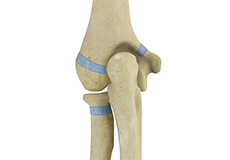
What is a Little League Elbow?
Little league elbow, also called medial apophysitis, is an overuse condition that occurs when there is overstress or injury to the inside portion of the elbow. It is commonly seen in children or adolescents involved in sports activities that require repetitive throwing such as baseball.
Causes of Little League Elbow
Children make use of the elbow joint repetitively to throw the baseball which creates stress on the muscles and ligaments that are attached to the inner side of the elbow. The growth plate at the lower end of the humerus bone can become inflamed, or in severe cases, it may fracture from the upper arm. One of the risk factors that causes this condition is misguided training regime.
Symptoms of Little League Elbow
The most common symptoms include elbow pain, tenderness, swelling on the inner side of the elbow, and restricted motion. Pain is increased upon pressing the inner side of the elbow.
Diagnosis of Little League Elbow
Your doctor will perform a physical examination of your child’s elbow. Further, your doctor will request an X-ray, which may show a break or widening in the growth plate.
Treatment Options for Little League Elbow
Immediately following an injury and before being evaluated by a doctor, you should initiate the PRICE method of treatment.
- Protection: The purpose of protection is to avoid further injury. You can protect the injury by applying a bandage, splint, protective tape or brace.
- Rest: Rest the elbow, as more damage could result from putting pressure on the injured area. If the injury is not treated it can lead to complications such as ligament tear, cartilage injury and growth disturbance.
- Ice: Applying ice packs to the injured area will help to diminish swelling and pain. Ice should be applied over a towel to the affected area for 15-20 minutes. Never place ice directly over the skin.
- Compression: Wrapping the elbow with an elastic bandage will help minimize the swelling and support the elbow.
- Elevation: Ensure that your child elevates the elbow above heart level as it will reduce swelling and pain.
The treatment options are typically non-surgical. The conservative or non-surgical options include:
- Resting the arm to limit stress on the injured bone and allow for healing
- Medications such as non-steroidal anti-inflammatory drugs may be prescribed to provide relief from pain and inflammation.
- After the pain has subsided, your doctor may suggest initiation of a rehabilitation program which includes strengthening and stretching exercises to develop strength and muscle control.
In severe cases when there is a significant break in the bone, surgical treatment may be required.
The primary measure to prevent little leaguers elbow is reduction in the number of pitches a child throws. Before starting with the activity, your child should perform warm-up exercises.
Related Topics
- Triceps Injuries
- Osteochondritis Dissecans of the Capitellum
- Elbow Trauma
- Elbow Arthritis
- Bicep Tendon Tear at the Elbow
- Elbow Dislocation
- Triceps Tendonitis
- Elbow (Olecranon) Bursitis
- Elbow Sprain
- Tennis Elbow
- Golfer's Elbow
- Little League Elbow
- Nursemaid's Elbow
- Elbow Pain
- Elbow Contracture
- Distal Humerus Fractures of the Elbow
- Radial Head Fractures of the Elbow
- Elbow Fractures
- Ulnar Nerve Neuropathy
- Loose Bodies in the Elbow
- Radial Tunnel Syndrome
- Lateral Ulnar Collateral Ligament Injuries (Elbow)
- Post-traumatic Stiffness (Elbow)
- Cubital Tunnel Syndrome (Ulnar Nerve Entrapment)





